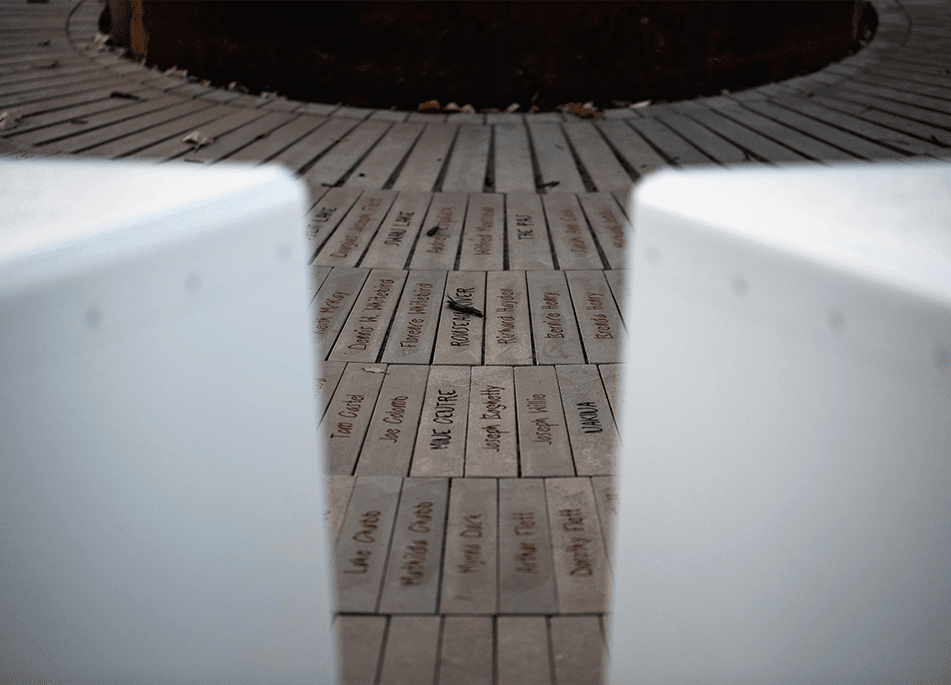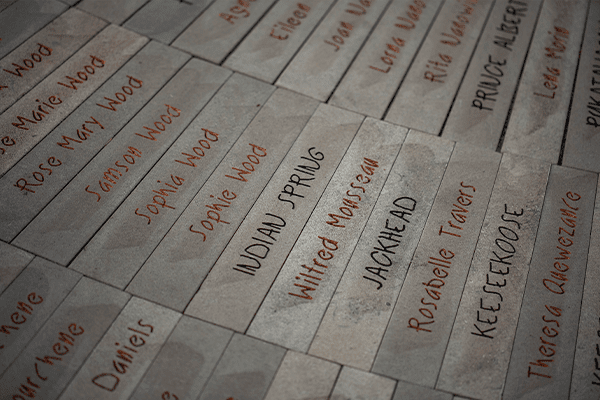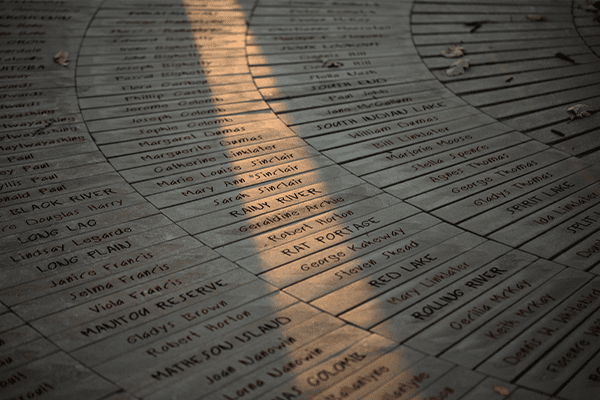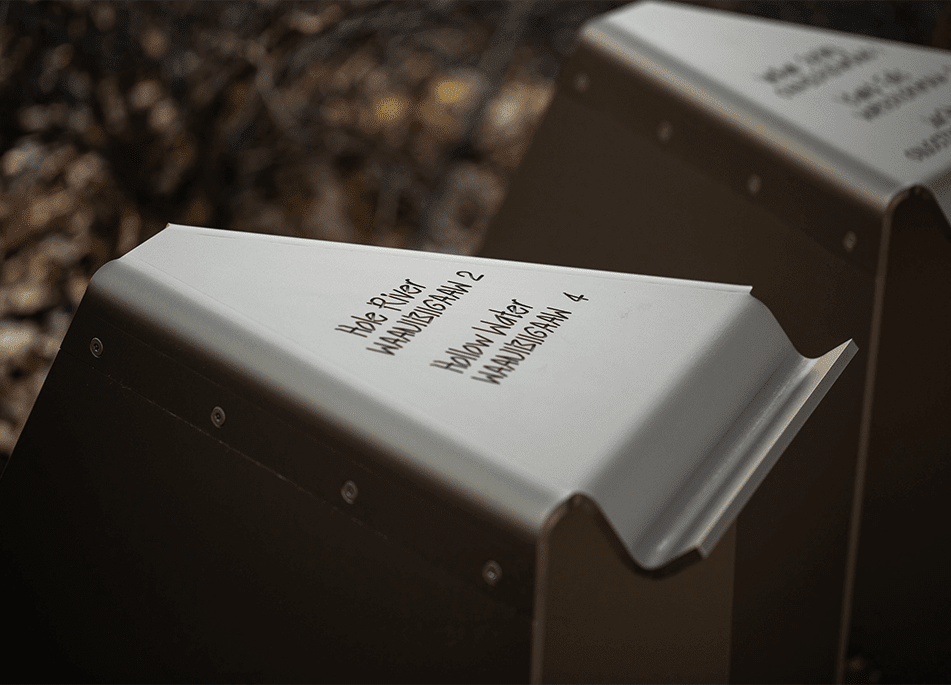Assiniboia Residential School Gathering Place
and Markers
The Assiniboia Residential School Gathering Place and Markers was inaugurated on 30 September, the second National Day of Truth and Reconciliation.

The Assiniboia Residential School Gathering Place and Markers was inaugurated on 30 September, the second National Day of Truth and Reconciliation.


Working together with the Assiniboia Residential School Legacy Group (ARSLG) over a 5-year period, the Gathering Place and Marker were designed by Prof. Herbert Enns as Collaborating Architect, with assistance from Darian McKinney, a recent graduate from the University of Manitoba Faculty of Architecture.
The plaza contains more than 760 names of the students who attended the school from 85 communities. The names are engraved into blocks of Indiana limestone and painted with copper. Both common and Indigenous community names are engraved on the top surface of the 28 anodized aluminum markers, together with the number of students from each community.
The markers are folded and formed to reference tipis, arrowheads, and school desks at child height. Situated in a circle around the sacred fire, they create a safe gathering place of reflection. The desk-height markers are tilted so that people with disabilities and varying abilities, as well as children, can easily read and examine them. Each marker carries a shelf upon which to place offerings of tobacco. The 28 markers are set in groups of 7 and organized by the four colours of the medicine wheel.
The plaza contains more than 760 names of the students who attended the school from 85 communities. The names are engraved into blocks of Indiana limestone and painted with copper. Both common and Indigenous community names are engraved on the top surface of the 28 anodized aluminum markers, together with the number of students from each community.
The markers are folded and formed to reference tipis, arrowheads, and school desks at child height. Situated in a circle around the sacred fire, they create a safe gathering place of reflection. The desk-height markers are tilted so that people with disabilities and varying abilities, as well as children, can easily read and examine them. Each marker carries a shelf upon which to place offerings of tobacco. The 28 markers are set in groups of 7 and organized by the four colours of the medicine wheel.


Assiniboia, the font used for the names, was designed by Prof. Enns. The letter forms were derived from and inspired by the handwriting of Survivor David Montana Wesley, and his handwritten notes discovered in his photo album from his time at Assiniboia. It is one of the few and perhaps the only remaining examples of handwriting by an Assiniboia Survivor.
Lighting mounted within each marker illuminates the names on the plaza. A surrounding boardwalk in the shape of the rings of an oak tree removed from the site is framed with 8 oak-plank benches, and a field of natural Indigenous grasses – to be planted in the spring of 2023. The project addresses the Truth and Reconciliation Commission’s Calls to Action through collaboration. This strategy and commitment was established early in the process by Theodore Niizhotay Fontaine and the ARSLG Board, as well as through input from many agencies, institutions and individuals. The property acquisition process underlying the site transfer was completed over several years with the help and guidance of the RCMP and the City of Winnipeg.

Assiniboia, the font used for the names, was designed by Prof. Enns. The letter forms were derived from and inspired by the handwriting of Survivor David Montana Wesley, and his handwritten notes discovered in his photo album from his time at Assiniboia. It is one of the few and perhaps the only remaining examples of handwriting by an Assiniboia Survivor.
Lighting mounted within each marker illuminates the names on the plaza. A surrounding boardwalk in the shape of the rings of an oak tree removed from the site is framed with 8 oak-plank benches, and a field of natural Indigenous grasses – to be planted in the spring of 2023. The project addresses the Truth and Reconciliation Commission’s Calls to Action through collaboration. This strategy and commitment was established early in the process by Theodore Niizhotay Fontaine and the ARSLG Board, as well as through input from many agencies, institutions and individuals. The property acquisition process underlying the site transfer was completed over several years with the help and guidance of the RCMP and the City of Winnipeg.

Assiniboia Residential School Commemorative Monument & Gathering Place is located at 621 Academy Road in Winnipeg, Manitoba, Canada.
Our memorial site is located near a cluster of buildings on Academy Road in Winnipeg, with multiple tenants and very restricted parking for their staff. In the interest of being good neighbors, ARSLG has clarified parking restrictions with the owner of the buildings and parking lot.
Parking Restrictions at ARSLG Memorial Site: No parking is available in any of the parking spaces near the cluster of buildings that includes 611 to 621 Academy Road during business hours Monday to Friday, 8:30 a.m. to 4:30 p.m.
For visits during the business day, free parking is available on surrounding residential streets. The closest residential street parking is on Wellington Crescent South, which is just east of the site on the north side of Academy Road.
If you wish to visit the site after 4:30 during the week, you may use a parking spot in the adjacent parking lot during your visit.
Thank you for respecting these parking restrictions and helping us to be good neighbors to the tenants surrounding our memorial site.
Assiniboia Residential School Commemorative Monument & Gathering Place is located at 621 Academy Road in Winnipeg, Manitoba, Canada. We acknowledge we are on First Nations land, Turtle Island, inhabited by First Nations from time immemorial.For thousands of years, First Nations people—the Anishinaabe, Cree, Dakota, Dene, and Anishininew Nations—walked and lived on this land and knew it to be the centre of their lives and spirituality. The Anishinaabe call this land Manitou Ahbee, the place where the Creator resides.We acknowledge this became the homeland of the Métis people.We acknowledge and welcome the many people from countries all over the world who have come to join us, Turtle Island’s First Nations, in calling this land our home. We acknowledge we are now all bound together by Treaty 1.
—Theodore Fontaine